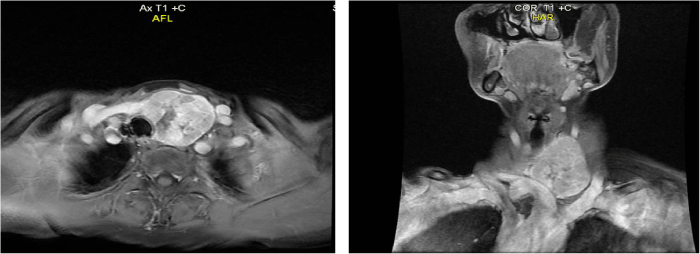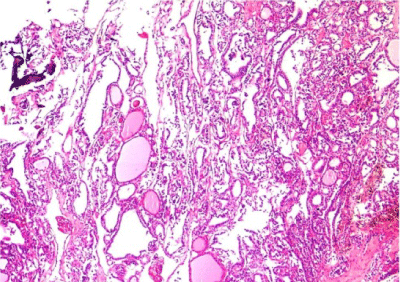The Case of Papillary Thyroid Carcinoma Presented with Lumbar Spine Metastasis
Received: 03-Jan-2015 / Accepted Date: 16-Feb-2015 / Published Date: 25-Feb-2015 DOI: 10.4172/2161-119X.1000189
Abstract
Papillary thyroid carcinoma is the most frequent thyroid malignancy with the best prognosis. It constitutes 80- 85% of differentiated thyroid carcinomas. Typically seen in the 3rd and 4th decades, papillary thyroid carcinoma is prevailed among women 2 times greater compared to men. In papillary thyroid carcinoma cases where local lymph node metastasis is frequently seen; lung, bone, and brain metastases are rarely determined. In this case report, the case of papillary thyroid carcinoma presented with lumbar spine metastasis was reported by reviewing the literature data.
Introduction
Thyroid carcinomas constitute more than 90% of all endocrine cancers. In differentiated thyroid carcinomas for which the rate of a 10-year survival is 80-95%; distant metastasis is rarely seen [1]. distant metastases at the time of diagnosis vary between 1% and 9% in different series in the literature. In their series, Ozkan et al., have reported a bone metastasis at the rate of 3.9% in differentiated thyroid carcinomas [2]. in their series which consisted of 1038 cases, Shaha et al., have specified that the presence of distant metastasis at the time of diagnosis is related to the histological type of the tumor and distant metastasis in papillary thyroid carcinoma is reported as 2.3% [3]. in the papillary thyroid carcinoma, 49% of distant metastases are in the lungs, 25% are in the bones, 15% are in both lungs and bones, and 12% are in the central nervous system and other organs [4]. cases with bone metastasis may be presented with clinical conditions that affect daily life such as fractures and spinal cord compression [5]. the rates of 5-year and 10- year survival in these cases are respectively 41% and 15% [6].
In our case report, the presentation of papillary thyroid carcinoma, which rarely causes bone metastasis, with distant metastasis is reviewed along with the literature data.
Case Report
During the examinations of the 51 year-old female patient who applied to the medical centre with the complaints of low back pain, hence difficulty in walking; a mass in l4 vertebral level was determined. In histological examination of the biopsy performed on the mass; upon determination of staining with thyroglobuline and cytokeratin 7, thyroid papillary carcinoma metastasis was decided and the patient was referred to our clinic. In the thyroid usg performed in our clinic, cystic degenerative areas that totally filled the localized lobe and a heterogeneous hypoechoic solid nodule that contains punctate calcifications were identified in the left lobe.
Furthermore, in the contrasted neck mr imaging; a solid nodule with the approximate size of 6×4×4 cm which had a heterogeneous hyperintense view in the thyroid gland left lobe in t2a examination and a heterogeneous mild hypointense view in t1a examination and involved non-homogeneous contrast was observed. The nodule displaced the trachea slightly to the right and was in the close vicinity laterally with the neck neurovascular package (Figures 1-2).
The nodule displaced the trachea slightly to the right and was in the close vicinity laterally with the neck neurovascular package.
In the contrasted lumbar spinal mr, a solid mass lesion with an approximate size of 5.5×4.5 cm which extended to the left pedicular and paravertebral soft tissue and appeared to be metastatic was observed (Figure 3).
After cytological findings compatible with the follicular neoplasia were obtained as a result of thyroid fine-needle aspiration biopsy [fnab] performed in our clinic, a total thyroidectomy operation was performed on the patient. When the resected piece was examined, a 5-cm-diameter solid nodular lesion filling completely the left lobe of the thyroid gland was determined (Figure 4).
In the pathological examination, the mass was determined to be a classical type of papillary thyroid carcinoma (Figure 5).
The patient, who did not have specific characteristics in her postoperative follow-ups, was referred to the brain surgery clinic for metastasectomy (Figure 6).
After lumbar involvement was identified in the scintigraphic examinations following the laminectomy and tumor excision, the patient was given a high dose of [200 mci] radioactive iodine treatment. The follow-ups of the patient, whose neurological deficit partly regressed after the treatment, have still continued.
Patient’s written consent was received for writing and publishing this article.
Discussion
Papillary thyroid carcinoma is the most frequent differentiated thyroid carcinoma with the best prognosis. It is more commonly prevailed among women and varies from society to society [7].papillary thyroid carcinoma remains silent for a long term. Distant organ involvement is rare compared to the other differentiated thyroid carcinomas. It is most commonly involved in local lymph nodes. Lung, bone, and central nervous system are frequently observed as distant organ metastasis. Lung involvement is more commonly prevailed among young cases [8]. bone metastases in differentiated thyroid carcinomas are observed among patients in their advanced ages, and 93% of cases are older than the age of 45 at the time of diagnosis. While 85% of cases have follicular thyroid carcinoma, 15% have papillary thyroid carcinoma. The size of the primary tumor and the development of bone metastasis are directly proportional. The most common symptom among the cases with bone metastasis is pain. Pain has been shown as the reason to seek medical advice for the first time before the diagnosis of differentiated thyroid carcinoma among approximately one-third of cases [9].
When series identifying bone metastases in the literature are examined, Ruegener et al., determined bone metastasis at the rate of 20% in their analysis [10]. In the retrospective analysis conducted by Coleman et al., it was specified that differentiated thyroid carcinomas caused spinal cord compression more often than breast and prostate carcinomas. This rate was determined as 10% in prostate carcinomas, 8% in breast carcinomas, and 28% in thyroid carcinomas [11]. in the analysis conducted by Haq et al., it was specified that the removal of primary lesion and metastatic focus reduces the tumor’s burden, minimizes complications and increases quality of life among differentiated thyroid carcinoma cases with distant metastasis. In a study conducted by Bernier et al., removal of all metastatic bone lesions increased survival rate considerably [6]. resistivity of bone metastases against rai treatment complicates treatment in these cases [12,13]. In our case, remission was ensured through total thyroidectomy, laminectomy and tumor excision, and high dose rai treatment due to the limited detection of metastatic focus on the vertebra.
Shoup et al., specified that age, metastasis location, tumor histology, and iodine affinity were important for prognosis in differentiated thyroid carcinomas with distant metastasis [14]. Falvo et al., found that the mortality rate was higher in patients older than the age of 51 [15]. Petrich et al., revealed that 93% of patients whose bone metastasis was identified during the diagnosis were older than the age of 45 [16].
Tnm classification supported by the american joint committee on cancer [ajcc] is used for staging differentiated thyroid carcinomas [17]. The patient was evaluated in stage 4c as she was older than the age of 45 and has metastatic focus.
Conclusion
Although differential diagnose is rare in patients applying with complaints of lombalgia and having identification of mass lesions in vertebra during the examinations. Although rare, papillary thyroid carcinoma metastasis should be considered for differential diagnoses in patients who applied with complaints of lombalgia and for whom mass lesion was identified in vertebra during the examinations.
References
- Schlumberger MJ (1998) Papillary and follicular thyroid carcinoma. N engl j med 338: 297-306.
- Ozkan E, Tokmak E, Tari P, Kucuk NO, YagciS (2010). Bone Metastases in Thyroid Carcinoma: A Retrospective Analysis. Turk J Nucl Med 19:16-22.
- Shaha AR, Shah JP, Loree TR (1997) Differentiated thyroid cancer presenting initially with distant metastasis. Am J Surg 174: 474-476.
- Becker k(eds) (2001) principles and practice of endocrinology and metabolism, Philadelphia. Lippincott Williams & wilkins 40: 382-396
- Schlumberger M, Tubiana M, De Vathaire F, Hill C, Gardet P, et al. (1986) Long-term results of treatment of 283 patients with lung and bone metastases from differentiated thyroid carcinoma. J Clin Endocrinol Metab 63: 960-967.
- Bernier MO, Leenhardt L, Hoang C, Aurengo A, Mary JY, et al. (2001) Survival and therapeutic modalities in patients with bone metastases of differentiated thyroid carcinomas. J Clin Endocrinol Metab 86: 1568-1573.
- Muro-Cacho CA, Ku NN (2000) Tumors of the thyroid gland: histologic and cytologic features--part 1. Cancer Control 7: 276-287.
- Sugitani I, Fujimoto Y, Yamamoto N (2008) Papillary thyroid carcinoma with distant metastases: survival predictors and the importance of local control. Surgery 143: 35-42.
- Zettinig G, Fueger BJ, Passler C, Kaserer K, Pirich C, et al. (2002) Long-term follow-up of patients with bone metastases from differentiated thyroid carcinoma -- surgery or conventional therapy? Clin Endocrinol (Oxf) 56: 377-382.
- Ruegemer JJ, Hay ID, Bergstralh EJ, Ryan JJ, Offord KP, et al. (1988) Distant metastases in differentiated thyroid carcinoma: a multivariate analysis of prognostic variables. J Clin Endocrinol Metab 67: 501-508.
- Coleman RE (2006) Clinical features of metastatic bone disease and risk of skeletal morbidity. Clin Cancer Res 12: 6243s-6249s.
- Haq M, Harmer C (2005) Differentiated thyroid carcinoma with distant metastases at presentation: prognostic factors and outcome. Clin Endocrinol (Oxf) 63: 87-93.
- Schlumberger M, Challeton C, De Vathaire F, Travagli JP, Gardet P, et al. (1996) Radioactive iodine treatment and external radiotherapy for lung and bone metastases from thyroid carcinoma. J Nucl Med 37: 598-605.
- Shoup M, Stojadinovic A, Nissan A, Ghossein RA, Freedman S, et al. (2003) Prognostic indicators of outcomes in patients with distant metastases from differentiated thyroid carcinoma. J Am Coll Surg 197: 191-197.
- Falvo L, Catania A, Sorrenti S, D'Andrea V, Berni A, et al. (2004) Prognostic significance of the age factor in the thyroid cancer: statistical analysis. J Surg Oncol 88: 217-222.
- Petrich T, Widjaja A, Musholt TJ, Hofmann M, Brunkhorst T, et al. (2001) Outcome after radioiodine therapy in 107 patients with differentiated thyroid carcinoma and initial bone metastases: side-effects and influence of age. European journal of nuclear medicine28: 203-208.
- Rosenberg SA, Hellman S (Eds) (2005) Cancer: principles & practice of oncology. Lippincott Williams & Wilkins 34: 1502-1519.
Citation: Durna YM, Yigit O, Acioglu E, Gunver F (2015) The Case of Papillary Thyroid Carcinoma Presented with Lumbar Spine Metastasis. Otolaryngology 5:189. DOI: 10.4172/2161-119X.1000189
Copyright: © 2015 Durna YM, et al. This is an open-access article distributed under the terms of the Creative Commons Attribution License, which permits unrestricted use, distribution, and reproduction in any medium, provided the original author and source are credited.
Share This Article
Recommended Journals
Open Access Journals
Article Tools
Article Usage
- Total views: 17845
- [From(publication date): 5-2015 - Dec 20, 2024]
- Breakdown by view type
- HTML page views: 13375
- PDF downloads: 4470





